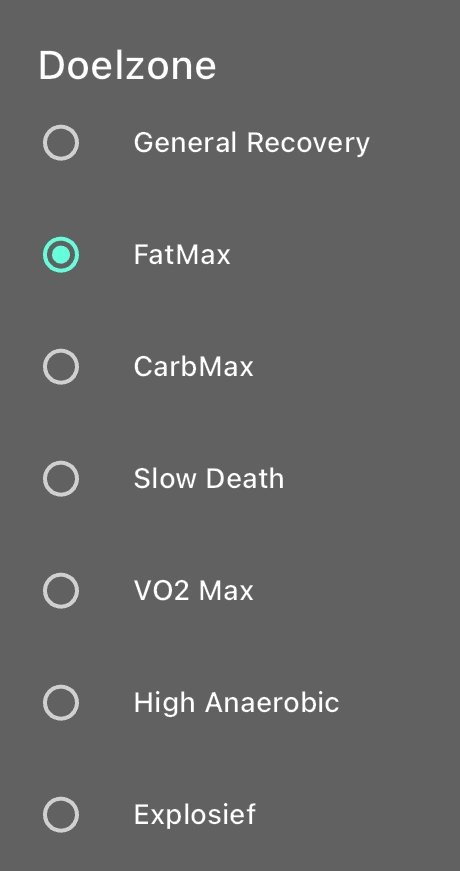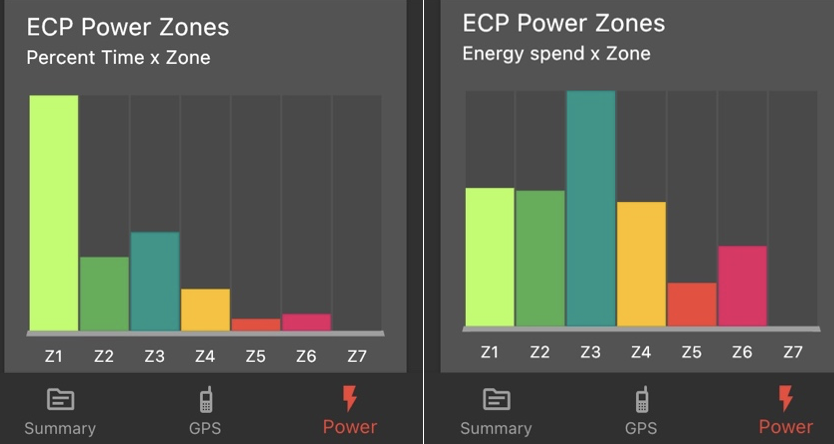Why SuperCycle is the most relevant cycling/training application.
The SuperCycle application with the "anaerobic reserve widget" as an
eye-catcher
To get straight to the point: because SuperCycle displays the anaerobic energy balance "live" based on the individual physiological profile and has a number of widgets that uniquely quantify the load on the various energy-providing mechanisms.
The most relevant data available "in the action"
The program identifies the essential values from the available MMP data, calculates the physiological profile of the rider and individualizes three “basic” effort zones from which three “load scores” are ultimately calculated.
What also makes SuperCycle unique is that FTP, Intensity Factor or TSS are not used. The Extended Critical Power concept (ECP) by C. Dauwe D.Sc. on which this app is based does not need these values. From now on we will speak of
• Recovery Threshold, a threshold power below which the effort is purely aerobic. Cycling in this aerobic zone results in an “aeobic load score” of 1 when the rider cycles at an intensity of RT for 1 hour. Moreover, the zone below RT is the zone where the recovery of the anaerobic reserve will take place.
• Super Critical Power or the power necessary to achieve VO2 max. The zone between RT and SCP is called the zone of Slow Death because here the aerobic contribution can still increase and therefore the anaerobic reserve is only used up moderately. On SCP the anaerobic contribution is less than 10%. The existence of this zone is extremely important and distinguishes itself from the traditional zones we know from other applications. High power values in this zone determine performance during long climbs. An SD score of 1 corresponds by definition to using up the anaerobic reserve once.
• The Fast Death zone is the exercise area where the anaerobic energy reserve is quickly used up because from SCP onwards, all additional energy must be supplied by the anaerobic system. An FD score of 1 corresponds by definition to using up the anaerobic reserve once.
To allow the rider or his coach to set more specific training goals or to evaluate the race progress in detail, sub-effort zones have been added.
The aerobic zone is divided into 3 sub-zones
General Recovery
Fat Max
Carb Max
The Fast Death zone also consists of 3 sub-zones
VO2max
High Anaerobic
Explosive
The Slow Death zone has no sub-zones.
During the ride, the 7 zones are displayed as colored icons, after the ride 2 graphs are created:
Important difference between time in zone and energy consumption per zone
Comparing these graphs provides valuable information as shown in the above analysis of a so called recovery workout. Although this rider does ride most of it in Z1, the second graph shows that the other zones are responsible for a lot of energy consumption. That cannot be the intention in this case.
But there is more. For comparison, the analysis in the SuperCycle app is also based on FTP power zones.
Clear evidence that making zones based on % FTP is not appropriate to evaluate the physiological background of exercise.
Furthermore, SuperCycle is available in 14 languages and has the same recording and setting options as other applications or cycling computers.
Power, heart rate, cadence, speed and others can be analysed and visualised in various ways. GPX files can be downloaded and there is possibility to transfer the .fit files of rides directly to TrainingPeaks or Strava.
Are all these possibilities overwhelming? Consult the very clear "Help" function where the "anaerobic reserve widget" is also discussed in detail or send a message to the developer.
Finally, incredible but true: the app is FREE and can be downloaded from the "App Store" and "Google Play".
More info at:
www.typhooncycling.org
www.sportim.be
The future of training and racing with a power meter





